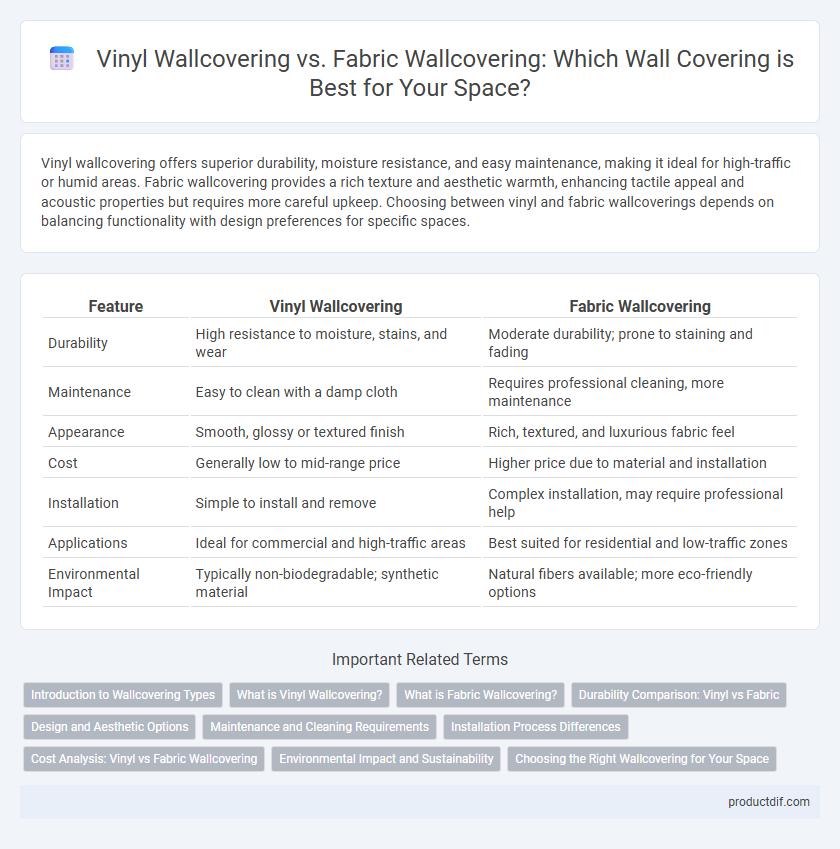Vinyl wallcovering offers superior durability, moisture resistance, and easy maintenance, making it ideal for high-traffic or humid areas. Fabric wallcovering provides a rich texture and aesthetic warmth, enhancing tactile appeal and acoustic properties but requires more careful upkeep. Choosing between vinyl and fabric wallcoverings depends on balancing functionality with design preferences for specific spaces.
Table of Comparison
| Feature | Vinyl Wallcovering | Fabric Wallcovering |
|---|---|---|
| Durability | High resistance to moisture, stains, and wear | Moderate durability; prone to staining and fading |
| Maintenance | Easy to clean with a damp cloth | Requires professional cleaning, more maintenance |
| Appearance | Smooth, glossy or textured finish | Rich, textured, and luxurious fabric feel |
| Cost | Generally low to mid-range price | Higher price due to material and installation |
| Installation | Simple to install and remove | Complex installation, may require professional help |
| Applications | Ideal for commercial and high-traffic areas | Best suited for residential and low-traffic zones |
| Environmental Impact | Typically non-biodegradable; synthetic material | Natural fibers available; more eco-friendly options |
Introduction to Wallcovering Types
Vinyl wallcovering offers durability, stain resistance, and easy maintenance, making it ideal for high-traffic areas and commercial spaces. Fabric wallcovering provides a textured, luxurious appearance with natural fibers like silk, linen, or cotton, enhancing aesthetic warmth and acoustic properties. Both types vary in installation techniques, cost, and maintenance requirements, influencing their suitability for residential or commercial applications.
What is Vinyl Wallcovering?
Vinyl wallcovering is a durable, water-resistant material made by coating fabric or paper with a layer of polyvinyl chloride (PVC), offering excellent moisture protection and easy maintenance. It is ideal for high-traffic areas and environments prone to humidity, such as kitchens and bathrooms, due to its stain-resistant and washable properties. Compared to fabric wallcovering, vinyl provides superior longevity and resistance to wear, making it a practical choice for both residential and commercial interiors.
What is Fabric Wallcovering?
Fabric wallcovering consists of textile materials such as silk, linen, or polyester bonded to a paper or vinyl backing, providing a textured and elegant finish for interior walls. Unlike vinyl wallcovering, fabric options offer superior breathability and sound absorption, making them ideal for creating a warm, inviting atmosphere in residential and commercial spaces. Fabric wallcoverings demand careful maintenance due to their delicate fibers but contribute premium aesthetic appeal and tactile richness that vinyl cannot replicate.
Durability Comparison: Vinyl vs Fabric
Vinyl wallcoverings offer superior durability compared to fabric wallcoverings due to their resistance to moisture, stains, and wear, making them ideal for high-traffic or humid areas. Fabric wallcoverings, while elegant and texturally rich, tend to be more susceptible to fading, staining, and damage from moisture, requiring more maintenance and careful cleaning. The robust composition of vinyl materials ensures a longer lifespan in demanding environments, whereas fabric options excel in aesthetic appeal but lack the same level of resilience.
Design and Aesthetic Options
Vinyl wallcoverings offer a wide variety of patterns, textures, and finishes, making them ideal for vibrant, durable designs suitable for high-traffic areas. Fabric wallcoverings provide a rich, luxurious appearance with a tactile, textured surface that enhances warmth and sophistication in interior spaces. While vinyl excels in versatility and maintenance, fabric options deliver unique aesthetic qualities through natural fibers and intricate weaving techniques.
Maintenance and Cleaning Requirements
Vinyl wallcoverings offer superior durability and are highly resistant to moisture, making them easy to clean with common household detergents and requiring minimal maintenance. Fabric wallcoverings, while providing a rich texture and aesthetic appeal, often demand delicate care, including gentle vacuuming and spot cleaning to prevent damage and staining. The choice between vinyl and fabric wallcoverings hinges on the desired balance of ease of maintenance versus decorative texture.
Installation Process Differences
Vinyl wallcoverings typically require a more straightforward installation process involving pre-pasted or peel-and-stick backing, making them ideal for DIY projects and moisture-prone areas. Fabric wallcoverings demand meticulous preparation, often needing professional adhesive application and precise alignment due to their delicate texture and potential for stretching or wrinkling. The choice between vinyl and fabric influences installation time, skill level, and durability on various surfaces.
Cost Analysis: Vinyl vs Fabric Wallcovering
Vinyl wallcovering typically costs between $1 to $6 per square foot, offering a budget-friendly option for durable and moisture-resistant surfaces. Fabric wallcovering ranges from $5 to $15 per square foot, reflecting higher expenses due to premium materials and intricate installation. Choosing vinyl wallcovering maximizes cost-efficiency for high-traffic or moisture-prone areas, while fabric wallcovering suits premium aesthetics despite increased investment.
Environmental Impact and Sustainability
Vinyl wallcoverings are made from polyvinyl chloride (PVC), a non-biodegradable material that releases harmful chemicals during production and disposal, contributing to environmental pollution and landfill waste. In contrast, fabric wallcoverings often use natural fibers like cotton or linen, which are biodegradable and have a lower environmental footprint, especially when sourced from organic or recycled materials. While fabric wallcoverings offer greater sustainability through renewable resources and better indoor air quality, their durability and maintenance requirements can influence overall environmental impact.
Choosing the Right Wallcovering for Your Space
Vinyl wallcoverings offer superior durability, moisture resistance, and ease of cleaning, making them ideal for high-traffic or humid environments such as kitchens and bathrooms. Fabric wallcoverings provide a luxurious texture and enhanced acoustic properties, perfect for living rooms, bedrooms, or spaces requiring a cozy, sophisticated ambiance. Selecting the right wallcovering depends on balancing practical needs like maintenance and durability with desired aesthetic and tactile qualities to ensure long-lasting satisfaction.
Vinyl Wallcovering vs Fabric Wallcovering Infographic

 productdif.com
productdif.com